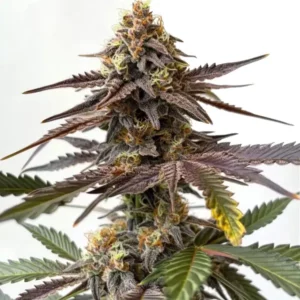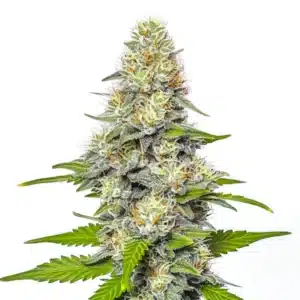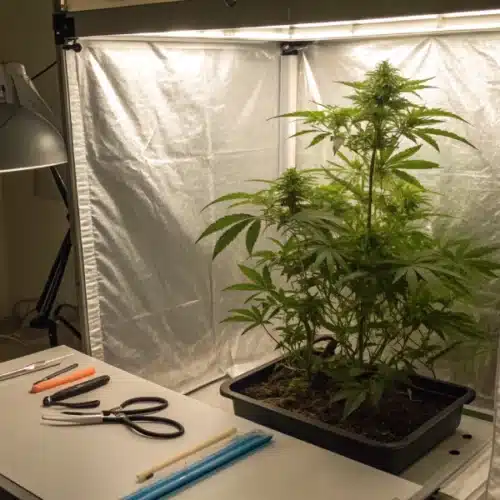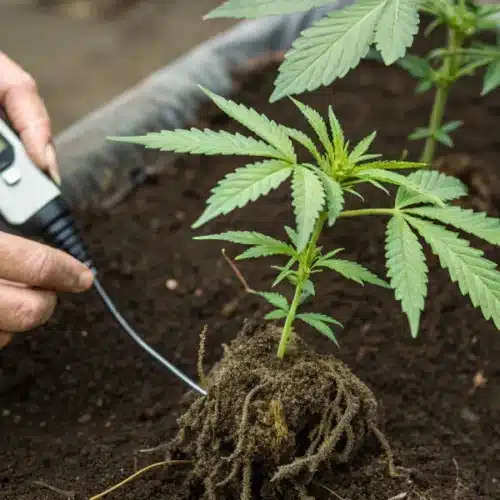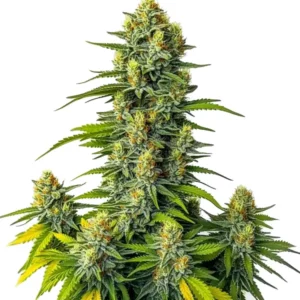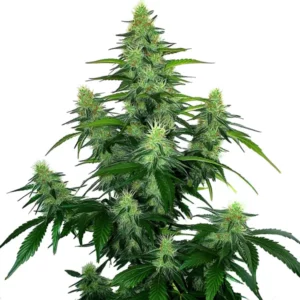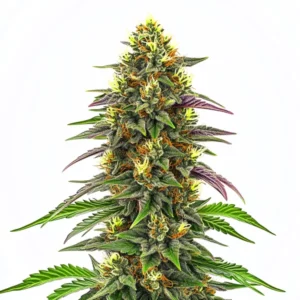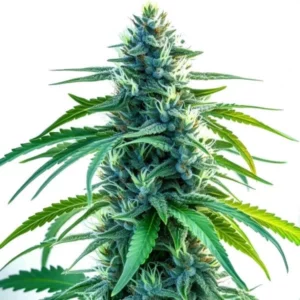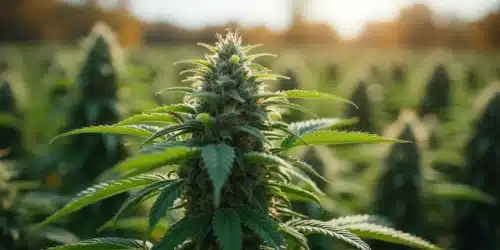Cherry Pie Autoflower Strain Cannabis Seed Description
Cherry Pie Autoflower is a highly sought-after cannabis strain known for its delightful aroma, flavor, and ease of cultivation. This strain is an autoflowering variety, making it suitable for both novice and experienced growers.
Recommended Strains
Cherry Pie Autoflower
 THC: 21% - 25%
THC: 21% - 25% Type of seed: Autoflowering
Type of seed: Autoflowering Phenotype: Mostly Indica
Phenotype: Mostly Indica Day to flower: 8 - 10 weeks
Day to flower: 8 - 10 weeks
Cherry Pie Auto is a cross between Cherry Pie strain and an autoflowering Ruderalis variety. It inherits the best traits from its parent strains, offering a well-balanced hybrid experience. The plants typically feature compact and bushy growth, making them ideal for indoor and discreet outdoor cultivation.
One of the most captivating aspects of this Strain is its sweet and fruity aroma, reminiscent of ripe cherries and baked goods. This delightful scent carries over into the flavor, providing a delicious and satisfying smoking or vaping experience.
Promos & Deals
Environmental Requirements for Growing Marijuana Cherry Pie Autoflower
Creating the ideal environment for your Cherry Pie Auto plants is essential for a successful cultivation process. The environmental requirements of this strain will help you achieve optimal growth and high-quality yields.
This Strain thrives in a temperate climate, with temperatures ranging between 70-80°F (21-27°C) during the day and slightly cooler temperatures at night. Maintaining a stable temperature and humidity level within the growing space is crucial to prevent stress or potential issues such as mold or mildew.
When growing Cherry Pie Autoflower indoors, it’s essential to provide adequate lighting. High-quality LED grow lights or HPS lamps are recommended to ensure proper photosynthesis and robust bud development. During the vegetative phase, provide a light cycle of 18-20 hours of light per day, and switch to 12 hours of light and 12 hours of uninterrupted darkness to initiate flowering.
For outdoor cultivation, choose a location with ample sunlight and a favorable climate. Cherry Pie Auto thrives in a sunny and warm environment, allowing it to reach its full potential. If you live in a region with cooler climates, consider using a greenhouse or providing additional protection to extend the growing season and safeguard your plants from adverse weather conditions.
Setting Up The Growing Cannabis Space
Before you begin growing this Strain, it is essential to set up an efficient and well-organized growing space. Whether you choose to cultivate indoors or outdoors, the following factors should be considered:
Indoor Cannabis Cultivation
For indoor growers, selecting the right grow tent or dedicated grow room is crucial. Ensure that the space provides sufficient room for the plants to grow vertically and has proper ventilation to maintain a fresh airflow. Install an efficient exhaust system with a carbon filter to control odors and prevent the accumulation of heat or humidity. Use reflective materials or Mylar sheets to maximize light distribution and avoid light leaks that could disrupt the flowering phase.
Choose a suitable growing medium for Cherry Pie seeds, such as high-quality soil or a hydroponic system, depending on your preferences and experience. Ensure proper drainage to prevent waterlogging and maintain a balanced pH level of around 6.0-6.5 for optimal nutrient absorption.
Outdoor Cannabis Cultivation
When cultivating Cherry Pie Auto outdoors, select a location with plenty of sunlight and suitable soil conditions. Ensure the soil is well-draining and rich in organic matter. Consider using large containers or fabric pots to have better control over soil quality and root health. Additionally, protect your plants from strong winds by placing them near a fence or using windbreaks.
Using stakes or trellises to support the branches of this Strain plants is recommended. This helps prevent the branches from bending or breaking under the weight of the developing buds and promotes better airflow.
Propagation and Germination of Marijuana Seeds Cherry Pie Autoflower
Successful germination and propagation are essential for healthy and vigorous Cherry Pie Autoflower plants. Follow these steps to ensure a high germination rate and successful propagation:
1. Start by selecting high-quality Cherry Pie Autoflower seeds from a reputable seed bank. This ensures genetic stability and the feminization of your plants.
2. Begin the germination process by soaking the seeds in distilled water or a damp paper towel for 24-48 hours. Maintain a temperature between 70-85°F (21-29°C) and provide a dark and undisturbed environment.
3. After the seeds have soaked and developed taproots, transfer them carefully to a pre-moistened growing medium, such as a seedling tray or small pots filled with a light and well-draining soil mix.
4. Place the seeds in a warm and humid environment with gentle airflow. Maintain a temperature around 75-80°F (24-27°C) and a humidity level of 60-70% for optimal germination.
5. Provide indirect light to the seedlings during the first few days, gradually increasing the light intensity as they develop. Avoid exposing them to intense light or heat that could cause stress or damage.
6. Once the seedlings have developed a few sets of true leaves, they are ready to be transplanted into larger pots or the final growing containers.
By following these germination and propagation steps, you can ensure a successful start for your Cherry Pie Auto plants and establish a strong foundation for healthy growth and abundant yields.
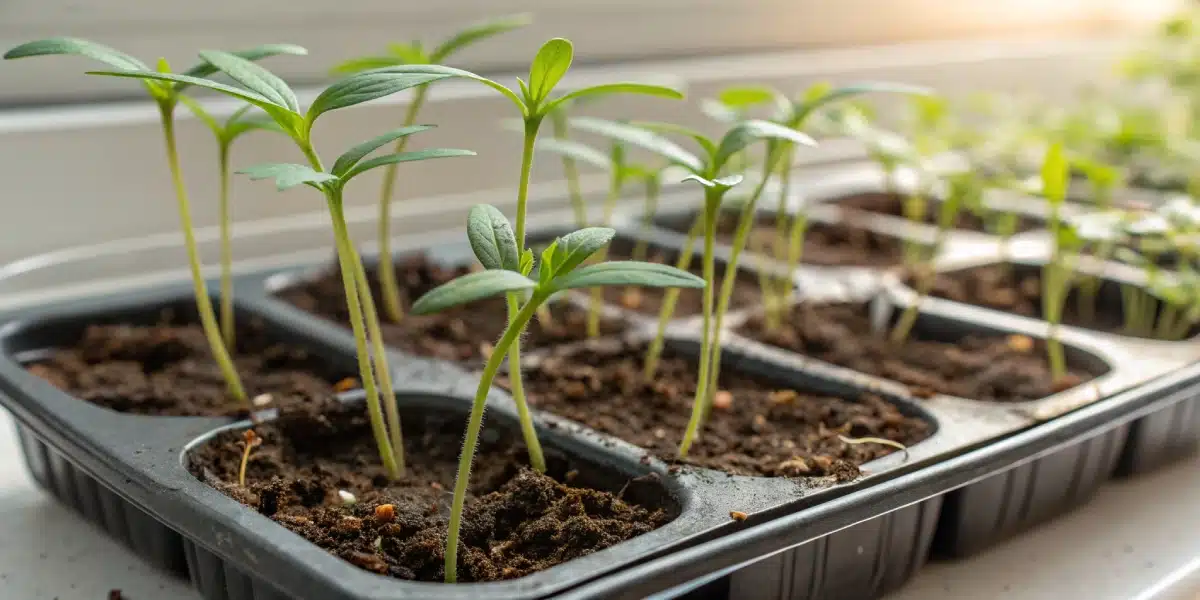
Vegetative Phase of Cannabis seeds Cherry Pie Auto
The vegetative phase is a crucial stage in the development of this plants. Here are some key considerations during this phase:
Lighting: Provide your Cherry Pie Autoflower plants with 18-20 hours of light per day to promote vigorous vegetative growth. High-quality LED grow lights or HPS lamps are recommended to ensure sufficient light intensity and spectral distribution.
Nutrition: During the vegetative phase, your Cherry Pie Auto plants require a balanced and nutrient-rich diet. Use a reputable cannabis fertilizer with a higher nitrogen (N) content to encourage healthy leaf and stem growth. Follow the manufacturer’s instructions and monitor the plants for any signs of nutrient deficiencies or excesses.
Watering: Water your plants when the top inch of the soil feels dry. Avoid overwatering, as it can lead to root rot and other moisture-related issues. Allow the soil to dry out slightly between watering sessions, but ensure the plants do not experience extreme drought.
Training: Consider employing training techniques such as low-stress training (LST) or topping to control the height and shape of this plants. These methods help create an even canopy, increase light penetration, and promote better bud development.
Pruning: Remove any lower branches or leaves that receive little light or show signs of disease or pests. This helps improve airflow and reduces the risk of mold or mildew formation.
By providing your Cherry Pie Autoflower Strain plants with the right environmental conditions, nutrition, and care during the vegetative phase, you can establish healthy and robust plants ready for the flowering stage.
Flowering Phase of Marijuana Seeds Cherry Pie Autoflower
The flowering phase is the most anticipated stage of growing Cherry Pie Auto, as it is when the plants develop their characteristic buds. Here’s what you need to know:
Lighting: Adjust the light cycle to 12 hours of light and 12 hours of uninterrupted darkness to initiate the flowering phase. Use a timer to maintain a consistent light schedule. During this stage,this Strain plants require intense light, so ensure your grow lights provide adequate coverage and maintain the appropriate distance from the canopy.
Nutrition: Transition from a nutrient formula higher in nitrogen to a bloom or flowering-specific nutrient formula. These formulations are generally higher in phosphorus (P) and potassium (K), which promote bud development and overall flowering performance. Monitor the plants closely and adjust nutrient levels as needed to avoid deficiencies or toxicities.
Temperature and Humidity: Maintain a slightly lower temperature during the flowering phase, ideally around 65-75°F (18-24°C), to encourage resin production and prevent heat-related stress. As for humidity, aim for levels around 40-50% to minimize the risk of mold or bud rot.
Support: As your Cherry Pie Autoflower plants enter the flowering phase, the weight of the developing buds may cause branches to bend or break. Provide adequate support using stakes or trellises to ensure the plants can bear the weight and avoid bud damage.
Flowering Time: Cherry Pie Auto typically has a flowering time of 8-10 weeks, but this can vary depending on the specific phenotype and environmental conditions. Monitor the trichome development using a magnifying tool to determine the optimal harvest window.
Throughout the flowering phase, maintain a vigilant eye for any signs of pests or diseases. Implement proper pest management practices and take immediate action at the first sight of infestation or abnormalities.
Cannabis Fertilization and Nutrition
Proper nutrition and fertilization are crucial for maximizing the growth, yield, and overall health of this plants. Consider the following tips:
Choosing the Right Fertilizer: Select a high-quality cannabis-specific fertilizer or nutrient line that provides a balanced blend of macro and micronutrients. Look for products rich in nitrogen (N), phosphorus (P), and potassium (K) to support healthy growth, root development, and bud formation.
Feeding Schedule: Follow the manufacturer’s instructions and adjust the feeding schedule based on your plants’ specific needs. Start with a lower concentration and gradually increase it as the plants progress through their growth stages. Monitor the plants closely for any signs of nutrient deficiencies or excesses, and make adjustments accordingly.
Supplements and Additives: Consider incorporating supplements and additives into your feeding regimen to enhance specific aspects of plant development. These may include bloom boosters, beneficial microbes, enzymes, or organic amendments that improve soil structure and nutrient availability.
Regularly monitor your plants’ response to the feeding program, adjusting nutrient concentrations and frequencies as needed. Remember to flush the plants with pure water during the final weeks of the flowering phase to remove any excess salts or nutrients, which can affect the flavor and overall quality of the final harvest.
Pest And Disease Control for Cannabis Growing
While Cherry Pie Auto is known for its resilience, it is still susceptible to pests and diseases. Implementing proper pest and disease control measures is crucial to protect your plants and ensure a successful cultivation. Here are some preventive and corrective actions:
Prevention:
- Regularly inspect your plants for any signs of pests, such as spider mites, aphids, or thrips. Early detection is key to preventing a full-blown infestation.
- Maintain a clean and tidy growing space, removing any dead plant material or debris that could harbor pests or pathogens.
- Introduce beneficial insects, such as ladybugs or predatory mites, to your garden to help control pests naturally.
- Ensure proper airflow and ventilation in the growing space to reduce the risk of mold or mildew formation.
- Quarantine new plants or clones before introducing them into your growing area to prevent the spread of pests or diseases.
Corrective Actions:
- If you detect pests, use organic or low-toxicity pest control products specifically formulated for cannabis. Follow the instructions carefully and avoid using harsh chemicals that can harm your plants or the environment.
If a fungal infection or mildew outbreak occurs, consider applying organic fungicides or neem oil to combat the issue. Ensure that the affected leaves or parts of the plant are removed and properly disposed of to prevent further spread.
Regularly monitor your plants for any unusual symptoms, discoloration, or damage. Prompt action is essential to mitigate the impact of pests or diseases on your Cherry Pie Autoflower Strain crop.
Harvesting and Curing for Cannabis Growing
Harvesting and curing this buds properly is the final step in the cultivation process. To ensure the best flavor, potency, and overall quality, follow these guidelines:
Harvest Timing: To determine the optimal harvest time, closely examine the trichomes on the buds using a magnifying tool. Harvest when most of the trichomes have turned cloudy or milky, with some amber trichomes for a more relaxing effect. Avoid harvesting when trichomes are mostly clear, as this indicates premature buds.
Harvesting: Use clean, sharp scissors or pruning shears to carefully cut each branch at the base. Handle the buds gently to avoid damaging the delicate trichomes. Remove any excess fan leaves, but leave small sugar leaves intact, as they also contain valuable cannabinoids and terpenes.
Drying: Hang the harvested branches in a dark and well-ventilated drying room with a temperature of around 60-70°F (15-21°C) and a humidity level of 45-55%. Allow the buds to dry slowly for 7-10 days, checking the moisture content regularly. Proper drying prevents mold and ensures a smoother curing process.
Curing: After drying, transfer the buds to airtight glass jars. Burp the jars daily during the first week by opening them for a few minutes to release excess moisture and promote even curing. Gradually reduce the burping frequency to once a week over the next few weeks. Proper curing can take 2-8 weeks or longer, depending on your preference and the desired flavor profile.
Storage: Store your cured Cherry Pie Autoflower buds in a cool, dark, and dry place to preserve their quality. Use glass or plastic containers with airtight seals to prevent air and light exposure, which can degrade cannabinoids and terpenes.
Cherry Pie Autoflower Strain: Indica or Sativa?
This Strain is considered a hybrid strain, combining both indica and sativa genetics. However, its exact genetic makeup may vary depending on the breeder and phenotype. Typically, Cherry Pie Autoflower leans slightly more towards the indica side, offering relaxing and euphoric effects with a touch of cerebral stimulation.
Indica-dominant strains like Cherry Pie Auto often provide a sense of physical relaxation and relief from pain and stress, making them suitable for evening or nighttime use. They may also enhance appetite and induce a calming body high.
It’s important to note that individual experiences with Cherry Pie Autoflower Strain may vary, and the effects can depend on factors such as dosage, tolerance, and personal preferences. If you’re looking for a strain that balances both indica and sativa characteristics, this Strain is an excellent choice.
Advantages of Growing Cherry Pie Autoflower Seeds
There are several advantages to growing Cherry Pie Autoflower cannabis seeds:
- Quick Harvest: Cherry Pie Auto has a shorter life cycle and typically matures faster than photoperiod strains. This allows for quicker harvests, making it suitable for growers looking for a faster turnaround.
- Compact Size: This plants tend to stay relatively small and bushy, making them ideal for indoor or discreet outdoor cultivation. Their compact size makes them easier to manage and conceal.
- Delightful Flavor and Aroma: Cherry Pie Autoflower Strain is known for its sweet and fruity aroma, which carries over into the flavor. The delightful taste and aroma make it a favorite among cannabis enthusiasts.
- Resilience: This strain is relatively resilient and can tolerate minor fluctuations in environmental conditions. It is suitable for both novice and experienced growers looking for a forgiving strain.
- Indica-Sativa Balance: Cherry Pie Auto offers a well-balanced hybrid experience, providing relaxation and euphoria without being overly sedating. It appeals to a wide range of consumers seeking a versatile cannabis strain.
Disadvantages of Growing Cherry Pie Autoflower Seeds
While this Strain has many advantages, it’s essential to be aware of potential disadvantages:
- Yield Size: Cherry Pie Autoflower Strain plants tend to produce smaller yields compared to some photoperiod strains. If maximum yield is your primary goal, other strains might be more suitable.
- Limited Control: The autoflowering nature of this strain means that you have limited control over the vegetative and flowering phases. You cannot extend the vegetative phase to increase plant size or recovery time, as you can with photoperiod strains.
- Light Sensitivity: Cherry Pie Auto plants are sensitive to light interruptions during their dark periods, which can stress the plants and potentially affect their growth and flowering. Ensuring a consistent light schedule is crucial.
- Complex Nutrient Requirements: While resilient, this plants can have specific nutrient requirements that may need adjustment during different growth stages. Beginners may find it challenging to fine-tune the feeding regimen.
Why buy Cherry Pie Autoflower Strain Marijuana Seeds
There are several compelling reasons to consider buying Cherry Pie Autoflower Strain marijuana seeds:
- Quality Genetics: Purchasing seeds from reputable seed banks ensures that you receive high-quality, genetically stable Cherry Pie Autoflower Strain seeds that are more likely to produce healthy and robust plants.
- Genetic Consistency: Feminized seeds are often available, guaranteeing that your plants will be female and capable of producing buds. This eliminates the risk of male plants, which do not produce flowers.
- Convenience: Buying seeds allows you to skip the process of selecting and cloning mother plants, saving time and effort. It also provides the freedom to choose how many plants you want to grow.
- Variety: Seed banks offer a wide range of cannabis strains, allowing you to explore different flavors, effects, and growth characteristics. Cherry Pie Autoflower is just one of many options available to cannabis cultivators.
- Privacy and Security: Purchasing seeds online from reputable sources typically comes with discreet packaging and secure payment options, ensuring your privacy and security throughout the process.
Before buying Cherry Pie Autoflower Strain marijuana seeds, research different seed banks, read customer reviews, and choose a trustworthy and reputable supplier to ensure a positive experience.
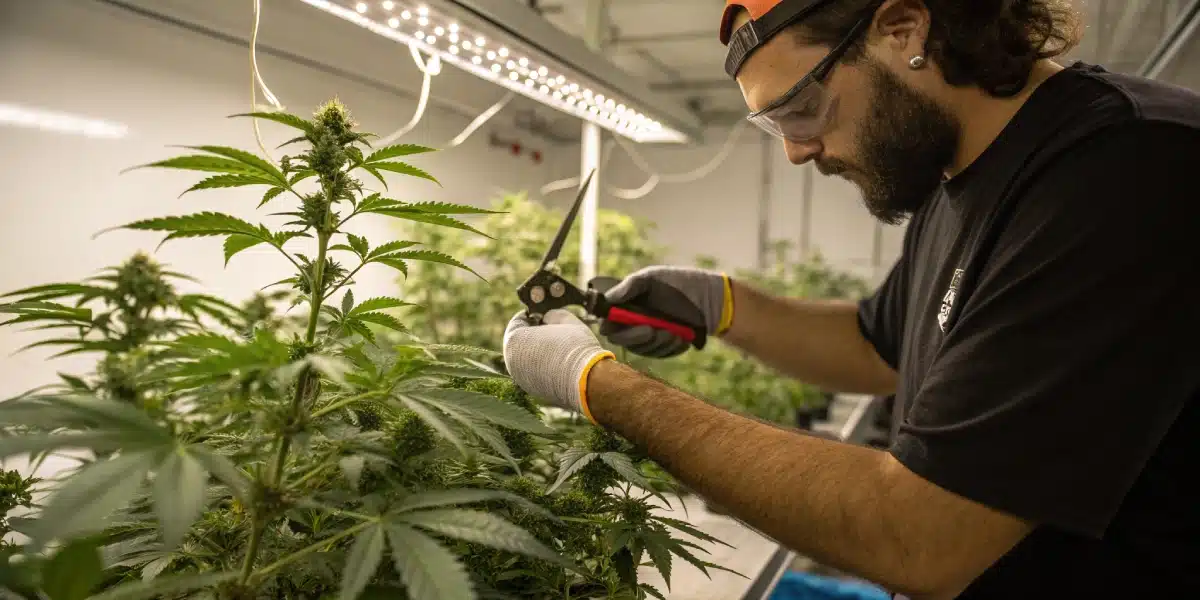
FAQs for How to Grow Cherry Pie Autoflower
What are the ideal growing conditions for Cherry Pie Autoflower?
Cherry Pie Autoflower thrives best under controlled environments. Aim for daytime temperatures between 75°F and 85°F, with nights 5°F cooler. Maintain humidity at approximately 50-60%. Ensure excellent airflow, sufficient ventilation, and full-spectrum lighting indoors. Outdoors, select a sunny location with well-draining soil and protection from extreme weather conditions for success.
How should I manage nutrients for Cherry Pie Autoflower?
Use a balanced nutrient schedule starting with higher nitrogen during the vegetative stage and switching to phosphorus and potassium in the flowering phase. Follow manufacturer recommendations closely. Monitor plant response and adjust feeding accordingly. Supplement with organic additives, ensuring pH levels remain stable between 6.0 and 6.5 for optimal growth.
What are common challenges when growing Cherry Pie Autoflower?
Common challenges include managing fluctuating temperatures, humidity, and nutrient imbalances. Overwatering may lead to root issues, while pests and mold can hinder growth. Additionally, inadequate lighting and ventilation cause stress. Regular monitoring, prompt adjustments, and preventive measures are essential to overcome these obstacles and ensure healthy Cherry Pie Autoflower plants.
When is the best time to harvest Cherry Pie Autoflower?
Harvest Cherry Pie Autoflower when trichomes shift from clear to milky with occasional amber hues. Timing is critical for maximizing potency and flavor. Monitor bud development closely using a magnifying tool. Proper timing ensures optimal resin production, enhancing the overall quality and effects of the final harvest for superior results.
What maintenance practices help Cherry Pie Autoflower thrive?
Regular maintenance includes pruning lower leaves, ensuring proper airflow, and monitoring nutrient levels and watering schedules. Maintain clean growing areas to prevent pests and mold. Adjust lighting and ventilation as plants mature. Consistent observation and interventions are key practices to support growth and maximize the yield of Cherry Pie Autoflower.


